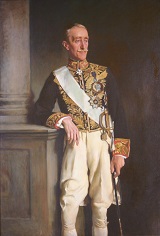
Lord Willingdon assumed his new duties as Governor General just as Canada embarked, domestically and internationally, on a new direction as an independent nation. Canada's change in status resulted from the Imperial Conference, held that same month, which gave the Dominions autonomy, making them equal to Britain. Consequently, Lord Willingdon was the first Governor General to represent the Crown and act on the advice of Canadian ministers rather than acting as an agent of the British government.
Lord Willingdon travelled throughout Canada and met with a wide variety of Canadians. He was the first Governor General to travel by air, flying from Ottawa to Montreal and back. In one of his early speeches after taking office, Lord Willingdon foresaw a destiny for Canada that many Canadians today would endorse: "I hope and pray that our country may take a long step forward towards the fulfilment of its destiny, that of becoming a great nation, exercising a powerful influence in securing peace and contentment among the people of the world".
The Prince of Wales and Prince George, with the Right Honourable Stanley Baldwin, Prime Minister of Great Britain, visited Canada in July 1927 to celebrate the 60th anniversary of Confederation. It was Canada's Diamond Jubilee and the joyful ringing of the new carillon for Parliament's Victoria Tower (now called the Peace Tower) was radio broadcast throughout the country on July 1. That same year, Governor General Willingdon travelled to Washington – the first official visit by a Governor General – and received State honours from the President of the United States. During this trip, he was received by Vincent Massey, the first Canadian minister to Washington (a position we now call Ambassador), who later served as Governor General from 1952 to 1959.
Governor General Willingdon was a keen sportsman. He particularly enjoyed fishing, golf, tennis, skating, skiing, curling and cricket, and he welcomed the opportunity to have many of the same sports played at Rideau Hall.
Both Lord and Lady Willingdon had an appreciation for the arts and they furnished Rideau Hall with rare carpets, screens and objets d'art they had collected during their travels in China and India. (In 1993, the Long Gallery at Rideau Hall was restored in the Chinese style of Lady Willingdon's time.) They also introduced the Willingdon Arts Competition which built on the Lord Grey Competition for Music and Drama, adding awards for painting and sculpture.
As his term of office drew to a close, the Great Depression was beginning its ruinous course and although Lord Willingdon was leaving Canada for a new posting in India, he often expressed his concern for the unemployed.
Life Before and After Rideau Hall
Before he became Canada's Governor General, Lord Willingdon had gained education and experience that made him well-suited for the position. He was schooled at Eton and Cambridge University and had a wealth of experience in the functions of government and overseas administration. His marriage to Lady Marie Adelaide was a source of strength to Lord Willingdon and a lifelong partnership. On many occasions, he recognized the able support she had provided. "My wife", he once remarked, "has been a constant inspiration and encouragement." Together, they had two sons; the older was killed in action early in the First World War.
From 1900 - 1910, Lord Willingdon served as a Liberal member of Parliament. His life in politics ended when he took his seat in the House of Lords after being raised to the peerage on July 20, 1910 as Baron Willingdon of Ratton in the county Sussex. Lord Willingdon then acted as both Lord-in-Waiting and an enthusiastic tennis partner to His Majesty King George V.
Lord Willingdon began his experience in overseas administration as an aide-de-camp to his father-in-law, who was Governor of Victoria in Australia from 1897 - 1900. He was Governor of Bombay from 1913 to 1918, and then Governor of Madras from 1919 to 1924. On June 23, 1924, he was elevated to Viscount Willingdon. While on a diplomatic mission to China, he received word of his appointment on August 5, 1926 as Governor General of Canada.
After leaving Canada in 1931, Lord Willingdon served as Viceroy of India until 1936. In that capacity, he faced many challenges including Mahatma Gandhi's campaign of civil disobedience. Lady Willingdon is remembered in India for her work to improve human rights. After returning to England, Lord Willingdon was sworn in as a member of the Privy Council and elevated as the 1st Marquess of Willingdon. He was one of the first commoners to be raised to this level.
Lord Willingdon died in 1941; Lady Willingdon died in 1960.
